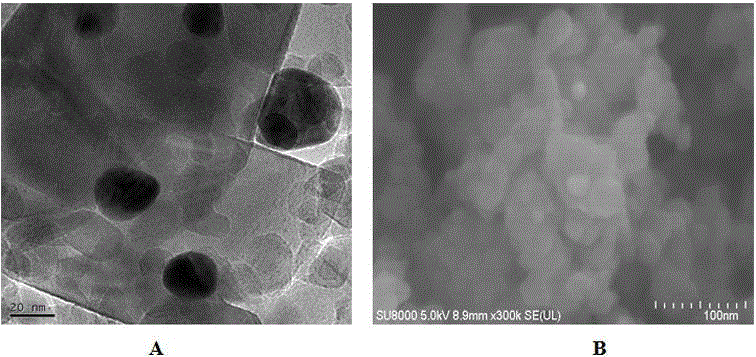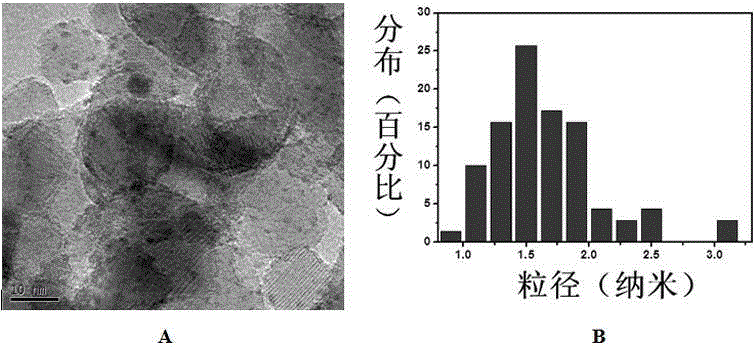Gold nanocluster-gold nanoparticle-titanium dioxide compound photocatalyst and application thereof
A gold nanocluster and gold nanoparticle technology, which is applied in the application field of gold nanocluster-gold nanoparticle-titanium dioxide composite photocatalyst and photo-splitting water for hydrogen production, can solve problems such as restricting the practical application of titanium dioxide, and achieves the Conducive to sustainable development, simple preparation method, and high photocatalytic activity
- Summary
- Abstract
- Description
- Claims
- Application Information
AI Technical Summary
Problems solved by technology
Method used
Image
Examples
preparation example Construction
[0025] A kind of gold nanocluster-gold nanoparticle-titanium dioxide composite photocatalyst, its preparation method comprises the following steps:
[0026] 1) Dissolve chloroauric acid in water, add reduced glutathione equal to the weight of chloroauric acid, stir until colorless, then reflux at 70°C for 24 hours, add acetonitrile for purification, centrifuge, wash and dry to obtain Solid gold nanoclusters, redispersing the obtained solid gold nanoclusters into water to obtain a gold nanocluster solution;
[0027] 2) According to the weight ratio of titanium dioxide nanoparticles and solid gold nanoclusters of 100:1~100:5, the solution of titanium dioxide nanoparticles and gold nanoclusters was mixed and stirred for 4 hours under weakly acidic conditions with a pH value of 4, centrifuged, Washing and drying to obtain a gold nanocluster-titanium dioxide composite material;
[0028] 3) Add 8mL of lactic acid as a sacrificial agent to the composite material obtained in step 2) ...
Embodiment 1
[0041]Dissolve 0.24g of chloroauric acid in 300mL of water, add 0.276g of reduced glutathione and stir until colorless, then reflux at 70°C for 24 hours, add 900mL of acetonitrile to purify after cooling, centrifuge, wash and dry the obtained The solid is redispersed into water to obtain a gold nanocluster solution; the weight ratio of the titanium dioxide nanoparticles to the solid gold nanoclusters is 100:3, the titanium dioxide nanoparticles are immersed in the gold nanocluster solution, and the pH value of the solution is adjusted to 4. Stir for 4 hours, centrifuge, wash, dry and grind to obtain a gold nanocluster-titanium dioxide composite material. The obtained gold nanocluster-titanium dioxide composite material was irradiated for 3 hours under the conditions of simulating sunlight, vacuum atmosphere, and adding lactic acid as a sacrificial agent. Particles to obtain a gold nanocluster-gold nanoparticle-titanium dioxide composite photocatalyst. The average particle siz...
Embodiment 2
[0043] Dissolve 0.24g of chloroauric acid in 300mL of water, add 0.276g of reduced glutathione and stir until colorless, then reflux at 70°C for 24 hours, add 900mL of acetonitrile to purify after cooling, centrifuge, wash and dry the obtained The solid is redispersed in water to obtain a gold nanocluster solution; the weight ratio of the titanium dioxide nanoparticles to the solid gold nanoclusters is 100:1, the titanium dioxide nanoparticles are immersed in the gold nanocluster solution, and the pH value of the solution is adjusted to 4. Stir for 4 hours, centrifuge, wash, dry and grind to obtain a gold nanocluster-titanium dioxide composite material. The obtained gold nanocluster-titanium dioxide composite material was irradiated for 60 hours under the conditions of simulating sunlight, vacuum atmosphere, and adding lactic acid as a sacrificial agent. Particles to obtain a gold nanocluster-gold nanoparticle-titanium dioxide composite photocatalyst. The average particle siz...
PUM
| Property | Measurement | Unit |
|---|---|---|
| wavelength | aaaaa | aaaaa |
| particle size | aaaaa | aaaaa |
| particle diameter | aaaaa | aaaaa |
Abstract
Description
Claims
Application Information
 Login to View More
Login to View More - R&D
- Intellectual Property
- Life Sciences
- Materials
- Tech Scout
- Unparalleled Data Quality
- Higher Quality Content
- 60% Fewer Hallucinations
Browse by: Latest US Patents, China's latest patents, Technical Efficacy Thesaurus, Application Domain, Technology Topic, Popular Technical Reports.
© 2025 PatSnap. All rights reserved.Legal|Privacy policy|Modern Slavery Act Transparency Statement|Sitemap|About US| Contact US: help@patsnap.com



